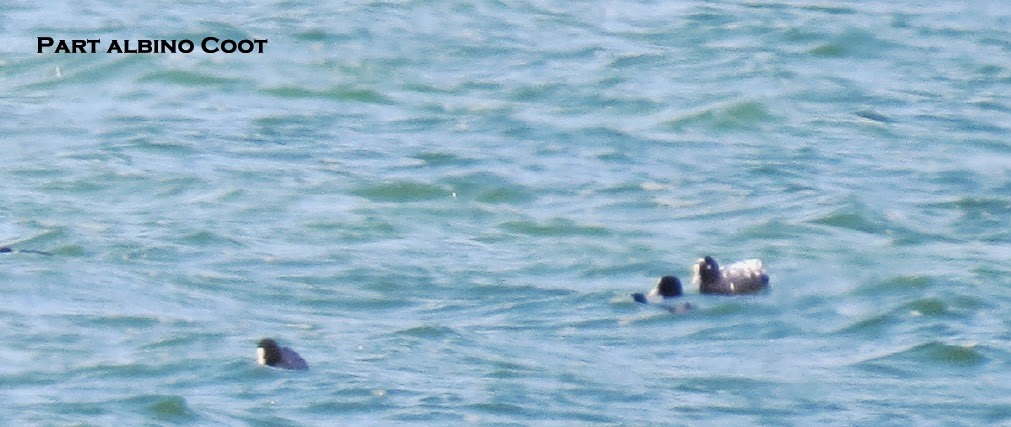 The lure of some shopping made
Sandra suggest we visited Las Norias and Roquetas this week and we're
glad that she did! Gilly and I were chauffeured down to the Jct 420
service station by Kevin where we met up with Rod, Linda, Colin, Sandra and John to have a coffee before heading into plastic greenhouse city,
Las Norias. At the first causeway we immediately saw that the water was
as flat as a tack and more disturbingly we had been joined by thousands
of mosquitoes!
The lure of some shopping made
Sandra suggest we visited Las Norias and Roquetas this week and we're
glad that she did! Gilly and I were chauffeured down to the Jct 420
service station by Kevin where we met up with Rod, Linda, Colin, Sandra and John to have a coffee before heading into plastic greenhouse city,
Las Norias. At the first causeway we immediately saw that the water was
as flat as a tack and more disturbingly we had been joined by thousands
of mosquitoes! There weren't many birds out and about. On the water were Great Crested Grebe, Coot, Moorhen, a Cormorant, Red-crested Pochard and a Little Grebe. We could hear a Great Reed Warbler shouting its song from the far reeds. It eventually showed itself. Round the back of the pump house we managed to see a singing Reed Warbler and a Hoopoe. Gilly spotted a Common Sandpiper. A Little Ringed Plover was also seen as were Yellow-legged and Black-headed Gulls. As we were about to leave two Little Terns flew over.
 It was next to the second
causeway, by the new heronry. Very concerned as there was only one
Little Egret there. I'd have thought there'd be far more activity by
this time of the year. There were numerous Great Reed Warblers singing to
the right. On the left hand lake we saw more Red-crested Pochards and
Great Crested Grebes. Most of the group walked up to the little bridge
whilst Gilly and Linda hung around the vehicles for security. We added
Grey Heron, Common Pochard, Kestrel and Red-rumped Swallow. Gilly and Linda saw a Purple Heron.
It was next to the second
causeway, by the new heronry. Very concerned as there was only one
Little Egret there. I'd have thought there'd be far more activity by
this time of the year. There were numerous Great Reed Warblers singing to
the right. On the left hand lake we saw more Red-crested Pochards and
Great Crested Grebes. Most of the group walked up to the little bridge
whilst Gilly and Linda hung around the vehicles for security. We added
Grey Heron, Common Pochard, Kestrel and Red-rumped Swallow. Gilly and Linda saw a Purple Heron. Personally I was slightly
disappointed as we headed towards the lake at Roquetas. After a coffee
stop we arrived by the lake. There were numerous Coot in a flotilla, one
was part albino with a white back. John spotted White-headed Duck.
Colin spotted a bird flying from the reeds on the far side to the reeds
to the right, the town side. It was Night Heron size but brown. Having
seen many juvenile Night Herons I knew it wasn't one of them. Having
checked "Collins" when I got home it was obviously a Bittern. Good spot,
Colin! As we were about to leave some Greater Flamingos were seen
flying.
Personally I was slightly
disappointed as we headed towards the lake at Roquetas. After a coffee
stop we arrived by the lake. There were numerous Coot in a flotilla, one
was part albino with a white back. John spotted White-headed Duck.
Colin spotted a bird flying from the reeds on the far side to the reeds
to the right, the town side. It was Night Heron size but brown. Having
seen many juvenile Night Herons I knew it wasn't one of them. Having
checked "Collins" when I got home it was obviously a Bittern. Good spot,
Colin! As we were about to leave some Greater Flamingos were seen
flying.

 These were followed numerically by 60+ Dunlin. Then there were the other lesser numbers of the 12 species of waders seen whichg included 30+ Ringed Plovers, 10+ Redshanks and 4 Common Sandpipers with singles of Ruff, Wood Sandpiper, Turnstone and Greenshank, plus, of course, the ever present and uncounted Black-winged Stilts and Avocets.
These were followed numerically by 60+ Dunlin. Then there were the other lesser numbers of the 12 species of waders seen whichg included 30+ Ringed Plovers, 10+ Redshanks and 4 Common Sandpipers with singles of Ruff, Wood Sandpiper, Turnstone and Greenshank, plus, of course, the ever present and uncounted Black-winged Stilts and Avocets.





















